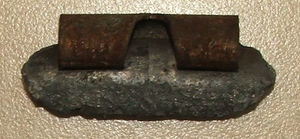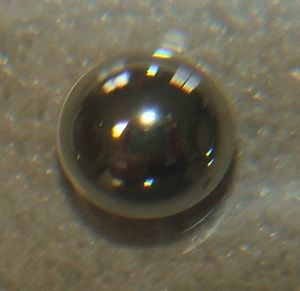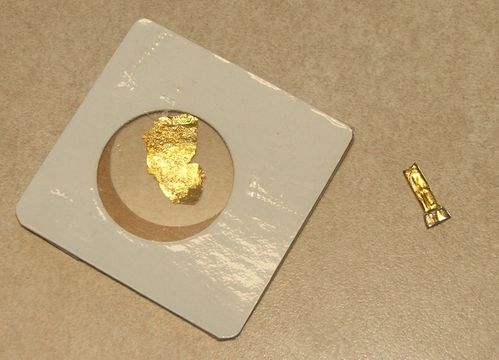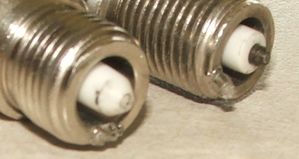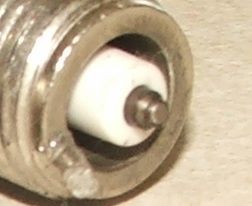Note: Unfortunately, there are no photographs in this document. I have, can produce, or can obtain the pictures of a large number of compounds, but posting hundreds of pictures in one post is difficult because of size restrictions on the hosting site. Instead, there are links to pictures. While most of these link to a JPEG file, there is no guarantee that all of these links are safe. Most are.
The elements on the periodic table form simple inorganic compounds with a wide range of color. Nowhere is this more evident than with the transition metals, although most elements have their own uniquely colorful compounds.
Below is a list of elements with a few of the colorful substances pertaining to each element. Radioactive elements such as plutonium and uranium are not included. This list makes no claim of completion; many elements have dozens of inorganic and organometallic complexes with vastly different colors and properties which are not mentioned here at all.
Alkali metals: The alkali metal compounds have no visible color from the metal. Other ions may contribute their coloration to a compound.
Alkaline earth metals: The alkaline earth metal compounds have no visible color from the metal. Other ions may contribute their coloration to a compound.
Aluminium, boron, gallium, and indium: None of these elements form any colored compounds when pure. Aluminium chloride is often colored slightly yellow.
Antimony: antimony trisulfide – dark gray or yellow, hexachloroantimony(V) acid – greenish, antimony(III) bromide – colorless solid and yellow liquid, antimony(III) iodide – red, ammonium antimony(IV) bromide – black, antimony(V) oxide – pale yellow, sodium thioantimonate(V) – yellow
Argon: See “Noble gases”.
Arsenic: arsenic – yellow or gray, arsenic(III) iodide – red, arsenic(II) iodide – red, realgar – red, arsenic(V) sulfide – yellow
Barium: See “Alkaline earth metals”.
Beryllium: See “Alkaline earth metals”.
Bismuth: bismuth(II) chloride – black, bismuth(III) bromide – yellow orange, bismuth(III) iodide – black, tetraiodobismuthate(III) - red orange, bismuth(III) oxide iodide – red, bismuth(III) oxide nitrite – light yellow, bismuth(III) oxide – light yellow, sodium bismuthate – light brown, bismuth(V) oxide – red, bismuth(III,V) oxide – brown
Boron: See “Aluminium, boron, gallium, and indium”. Boron - gray crystals or red brown powder.
Bromine: bromine – dark red liquid, cesium dichlorobromide – yellow, sodium hypobromite – yellow, bromine nitrate – pale yellow
Cadmium: cadmium sulfide – yellow, cadmium selenide – red, cadmium(II) oxide – white or brown
Caesium: See “Alkali metals”. Caesium forms many colorful complexes with halogens which are mentioned under each specific halogen.
Calcium: See “Alkaline earth metals”.
Carbon: Metal carbides often have a gray or blackish coloration. potassium carbide – copper colored or bluish gray, tricarbon disulfide – bright red liquid, carbon diselenide – bright yellow liquid
Cerium: Cerium dioxide - light yellowish. Cerium(IV) sulfate – bright yellow orange, cerium(IV) fluoride – brown powder, cerium(IV) ammonium nitrate – red
Chlorine: Chlorine - light yellow green, Sodium hypochlorite - light green in solution, chlorine dioxide -bright yellow green gas, dichlorine monoxide - brown gas, dichlorine hexoxide - red liquid
Chromium: chromium(II) chloride solution - blue, chromium(II) fluoride – dark green, chromium(II) iodide – brown, chromium(III) chloride – purple anhydrous and green hexahydrate with purplish gray or greenish gray or grayish solution, chromyl fluoride – red brown gas, chromyl chloride - red liquid, chromium(IV) fluoride – brown with blue vapor, chromium(III) oxide – blue green solid, alkali metal chromates – bright yellow, dichromates – orange, trichromates – red (left one in picture), chromium(VI) oxide – reddish purple, chromium(III) phosphate – grayish brown, chromium(II) acetate – dark red brown, chromium(III) acetate – purple blue
Cobalt: cobalt(II) chloride - blue anhydrous and pink hexahydrate, cobalt(II) ammine complex – tan, cobalt(II) bromide - green anhydrous and pink hexahydrate, cobalt(II) iodide - black or yellow anhydrous and pink hexahydrate, cobalt(II) oxide - olive green, cobalt(II,III) oxide – black, cobalt(II) hydroxide - red or blue, cobalt(III) sulfate – green, sodium cobaltinitrite – yellow, cobalt(II) carbonate - indigo, cobalt(II) phosphate – purple, cobalt borate – tan, cobalt chloro complex - violet to greenish-blue, cobalt(III) ammine - orange or purple
Copper: copper – pinkish red, copper(I) oxide - yellow or red, copper(II) oxide – black, copper(II) carbonate – green blue, copper chloro complex – green to yellow, caesium copper(II) chloride – red orange, copper(II) chloride – brown when anhydrous and green or blue hydrate, copper(II) bromo complex – brownish or purplish, copper(II) bromide – black, copper(II) hydroxide – blue solid, copper(II) sulfate – gray anhydrous and blue pentahydrate, copper(I) acetylide – brown, copper(II) ammine complex – deep blue, copper(III) periodate complex - dark red
Dysprosium: dysprosium(III) chloride – yellow, dysprosium(III) nitrate – pale yellow
Erbium: erbium(III) oxide – pink, erbium(III) chloride – pink, erbium solutions - yellow
Europium: europium(III) oxide – pale pink, europium(III) carbonate - yellow, europium(III) chloride – yellow, europium(III) sulfate – pale pink
Fluorine: fluorine – brownish gas
Gadolinium: See “Rare earth metals”.
Gallium: See “Aluminium, boron, gallium, and indium”.
Germanium: germanium(II) oxide – yellow or brown, germanium(IV) iodide – orange red, germanium(II) iodide – yellow
Gold: gold – golden yellow, gold(I) chloride – yellow, gold(III) chloride – ruby red solid and yellow solution, potassium gold(III) chloride – light yellow, gold(III) oxide – black or brown, gold(I) sulfide – brown, gold(III) sulfide – black, gold(I) cyanide – yellow
Hafnium: hafnium(IV) iodide – red
Helium: See “Noble gases”.
Holmium: holmium(III) oxide – pale yellow or pink, holmium(III) chloride – yellow or pink
Indium: See “Aluminium, boron, gallium, and indium”.
Iodine: iodine – blue black crystals and purple vapor, iodine monochloride – brown liquid, iodine trichloride – orange or yellow, triiodide solution – dark brown, potassium dichloroiodide – orange, dibromoiodide – red, tetrachloroiodide – golden yellow, iodine(III) nitrate – yellow, diiodine tetroxide – yellow, cationic iodine - blue green
Iridium: iridium(IV) oxide – blue black, iridium(III) oxide – pale green, iridium(III) chloride – green, potassium iridium(IV) chloride – olive green, iridium(IV) chloride - purple or tan or green, tetrachloroiridate(IV) - deep red
Iron: iron(I) nitrosyl - green brown solution, iron(III) chloride – yellow brown solutions and solid, iron(II) chloride – yellow green solution, green hydrate, iron(III) bromide – black, ferrates in solution - light magenta, iron(II) hydroxide - white to greenish gray, iron(II,III) oxide - black, iron(III) oxide - red orange or brown, basic iron(III) acetate - red, ferric nitrate - light purplish, iron(III) ammonium sulfate – yellowish or purplish, Prussian blue – blue, ferricyanic acid - yellow or brown solution, potassium ferricyanide - red, tetrachloroferrate(III) - yellow, potassium ferrocyanide - light yellow
Krypton: See “Noble gases”.
Lanthanum: See “Rare earth metals”.
Lead: lead(II) oxide – light yellow or red, lead(II,IV) oxide – bright red, lead(IV) oxide – dark brown, lead(IV) chloride – yellow, ammonium lead(IV) chloride – yellow, potassium lead(II) iodide – light yellow, sodium metaplumbate or orthoplumbate – yellow, lead(II) sulfide – gray , lead(IV) sulfate – white or yellow green, lead(II) iodide – bright yellow to red, lead(II) chromate – bright yellow
Lithium: See “Alkali metals”.
Lutetium: See “Rare earth metals”.
Magnesium: See “Alkaline earth metals”.
Manganese: permanganate solutions - magenta, solid permanganates - dark purple, manganate(VI) solutions - green, manganate(V) – blue, manganese(III) chloro complex - brownish, manganese(II) chloride - light pink, manganese dioxide - black, manganese(II) hydroxide – light tan, manganese heptoxide - greenish or reddish oil, manganese(III) sulfate - dark green, caesium manganese(III) sulfate – red, manganese(III) acetate – brown
Mercury: mercury(II) oxychloride – brown, potassium mercury(II) iodide – light yellow, copper(I) mercury(II) iodide – red or brown, mercury(II) sulfide – red or black, mercury(II) selenide – gray, mercury(II) iodide – red or yellow, mercury(II) oxide – orange
Molybdenum: molybdenum blue – blue or olive, molybdenum(II) chloride – yellow, molybdenum(III) chloride – red brown, molybdenum(III) hydroxide - greenish gray, molybdenum(V) chloride – blue black, molybdenum(III) bromide – black, potassium molybdenum(III) chloride – red, molybdenum(IV) oxide – brown or violet, Mo4O11 – violet, molybdenum(VI) oxide – white or bluish when cool and yellow when heated, molybdic acid – yellow crystals, molybdenum(IV) sulfide – blue gray, ammonium molybdenum(V) oxychloride – green, zinc molybdenum peroxo complex – red brown, molybdenum(VI) peroxo complex - yellow
Neodymium: neodymium(III) oxide – sky blue or pink or purple, neodymium(III) fluoride – lilac, neodymium(III) chloride solutions – rose pink or almost colorless, neodymium(III) bromide – green solid and dark brown liquid
Neon: See “Noble gases”.
Nickel: nickel – golden tinged gray, nickel(II) aqua solutions - green, nickel(II) chloro complex – yellow, nickel(II) ammine complex – blue, nickel(II) chloride – yellow green anhydrous and blue green hexahydrate, nickel(II) iodide - black anhydrous and blue green hydrate, nickel(II) oxide - green, nickel(III) oxide – black, nickel(II) thiocyanate – brown, potassium nickel(II) cyanide - orange
Niobium: niobium(V) chloride – yellow, niobium(II) chloride – brown, niobium(III) chloride – green black, niobium(IV) chloride – brown black, niobium(V) bromide – red, niobium(IV) iodide – dark gray, niobium(II) iodide – gray black, niobium(V) oxide – white when cool and yellow when heated, niobium(V) peroxo complex - yellow
Nitrogen: nitrogen dioxide – brown gas, nitric oxide –colorless gas and blue liquid, dinitrogen trioxide – blue liquid, nitrogen triiodide – dark brown powder, nitrosyl chloride – orange gas, lithium nitride – ruby red
Noble gases: The noble gases are colorless.
Osmium: osmium(IV) chloride – red brown or black, ammonium osmium(IV) chloride – dark red, osmium(IV) oxide – black, potassium osmate(VI) – pale violet red
Oxygen: dioxygen difluoride – brown gas, red liquid, ozone – light bluish gas, hydrogen peroxide- very pale bluish liquid, lithium and sodium peroxides - yellowish
Palladium: palladium(II) chloride – red brown solid and brown solution, palladium(II) oxide – black, potassium palladium(II) chloride – dark yellow or brown, ammonium palladium(II) chloride – olive green, palladium(IV) chloride complex – bright red, potassium palladium(IV) chloride - orange, palladium(II) ammine complexes – red or yellow, palladium(IV) oxide - dark red
Phosphorus: phosphorus – yellowish, red brown, or violet, diphosphorus tetraiodide – red, phosphorus trisulfide - yellow brown, phosphorus triselenide - orange, phosphorus pentabromide - yellow
Platinum: platinum(IV) chloride – reddish brown, platinum(III) chloride – dark green, platinum(II) chloride – greenish brown, chloroplatinic(IV) acid – orange, chloroplatinic(II) acid solution – red, potassium platinum(IV) chloride – yellow, potassium platinum(II) chloride – red, platinum(II) oxide – black, platinum(IV) oxide – yellow, potassium platinum(II) cyanide – blue or yellow, platinum(II) ammine complex – dark colored or yellow
Potassium: See “Alkali metals”.
Praseodymium: Praseodymium(III) chloride – bluish green when anhydrous and green when heptahydrated, praseodymium(III) fluoride – green, praseodymium(IV) oxide - black (top center), praseodymium(III) oxide - light green
Rare earth metals: Lanthanum, yttrium, lutetium, gadolinium, and ytterbium have no visible color in the majority of their compounds.
Rhenium: rhenium(III) chloride – red purple, rhenium(V) chloride – black brown, rhenium(IV) chloride complex – yellow green, rhenium(VI) oxychloride – red brown, rhenium(IV) oxide – gray black, rhenium(VI) oxide – red, rhenium(VII) oxide – bright yellow, sodium rhenite(IV) – brown, barium rhenate(VI) – green, rhenium(IV) sulfide – black, rhenium(VII) sulfide – black
Rhodium: rhodium(III) chloride – yellow HCl solution or red solid, rhodium(III) oxide – lemon yellow, rhodium(III) sulfate – red or yellow , rhodium(II) sulfate - red
Rubidium: See “Alkali metals”.
Ruthenium: ruthenium(IV) oxychloride – dark brown, ruthenium(III) chloride – yellow brown solution, ruthenium(IV) oxide – dark gray, ruthenium(IV) chloride complex – orange brown, ruthenium(VIII) oxide – yellow solid or solution and orange liquid, ruthenate - red, potassium perruthenate – black solid and green solution, ruthenium(II) - lavender
Samarium: samarium(III) oxide – light yellow, samarium(III) sulfate – yellow, samarium(III) iodide – orange, samarium(II) iodide – yellow with brown solution
Scandium: Scandium iodide – yellow (in light bulb core), scandium sulfide – yellow
Selenium: selenium – red or purplish gray or black, diselenium dichloride – dark red liquid, selenium tetrachloride – faint yellow, ammonium selenium chloride – yellow, diselenium dibromide – black liquid, selenium tetrabromide – yellow, selenium oxychloride – yellow liquid, selenium sulfur trioxide – dark green, selenium nitride – orange
Silicon: Silicon – bluish, silicon tetraiodide - yellow liquid, colorless solid
Silver: silver(I) oxide – dark brown, silver(I) carbonate – light yellowish, silver(I) iodide – light yellowish, silver(I) sulfide – black, silver(II) oxide – grayish, sodium argentite – light green, silver nitride – black
Sodium: See “Alkali metals”.
Strontium: See “Alkaline earth metals”.
Sulfur: Sulfur - yellow solid and red when molten, sulfur dichloride – red liquid, disulfur dibromide - red liquid, disulfur dichloride - yellow liquid, disulfur trioxide – greenish, thionyl bromide - yellow liquid, sulfur nitrides – yellow orange. Alkali metal sulfides turn yellow upon exposure to air.
Tantalum: tantalum(IV) chloride – brown, tantalum(IV) bromide – black, tantalum(V) bromide – yellow, tantalum(V) iodide – black
Tellurium: potassium telluride – pale yellow, chlorotellurate(IV) and bromotellurate(IV) - orange or yellow, iodotellurate(IV) – gray, tellurium(VI) oxide – yellow or gray, tellurium sulfur trioxide – brown
Terbium: Tb4O7 – dark brown, terbium solutions – pale pink
Thallium: thallium(I) fluoride – yellow, thallium(I) bromide – pale yellow green, thallium(I) iodide – yellow or red, thallium(III) bromide – light yellow, rubidium thallium(III) bromide – yellow, thallium(I) triiodide – black, thallium(I) oxide – black, thallium(I) hydroxide – yellow, thallium(III) oxide – black, thallium(I) sulfide – black
Thulium: thulium(III) chloride – green, thulium(III) oxide - green
Tin: tin(II) iodide – orange, tin(IV) iodide – orange, tin(II) oxide – black, tin(II) bromide – bright yellow, tin(II) sulfide – brown, tin(IV) sulfide – gold yellow
Titanium: Titanium peroxo complex – orange, titanium(II) halides – black, titanium(III) chloride – violet, titanium(III) bromide – bluish black, titanium(III) iodide – violet, titanium tetrabromide – yellow orange, titanium disulfide – yellow, titanium nitride - yellow brown, titanium(III) hydroxide - dark blue, titanium(III) fluoro complex - green
Tungsten: tungsten(V) chloride – black, tungsten(VI) chloride – blue black, tungsten(IV) oxide – brown, W18O49 – red or violet, tungsten blue – brown to blue to violet, tungsten(VI) oxide – yellow, tungsten oxytetrachloride – red, tungsten sulfide – blue gray, potassium tungsten(III) chloride – dark green
Vanadium: vanadium(II) solution – lavender, vanadium(II) hydroxide - black, vanadium(III) solution – light green blue, vanadium(III) hydroxide - green gray, vanadium(IV) hydroxide - gray, vanadate(IV) solution - red brown, vanadium(IV) chloride – reddish liquid, vanadium(II) bromide – reddish brown, vanadium(II) sulfate – reddish brown, vanadium(III) bromide – black with violet vapor, vanadium(II) iodide – violet, vanadium(III) iodide – brown, vanadium oxychlorides – brown or green or yellowish or orange, vanadyl sulfate – bright blue, vanadates – light yellow, vanadium(V) oxide – orange brown, vanadium(V) peroxo complex - yellow and purple
Xenon: See “Noble gases”. Some xenon compounds may be colorful.
Ytterbium: See “Rare earth metals”.
Yttrium: See “Rare earth metals”.
Zinc: zinc oxide – white when cold and yellow when strongly heated
Zirconium: zirconium tetraiodide – red brown




